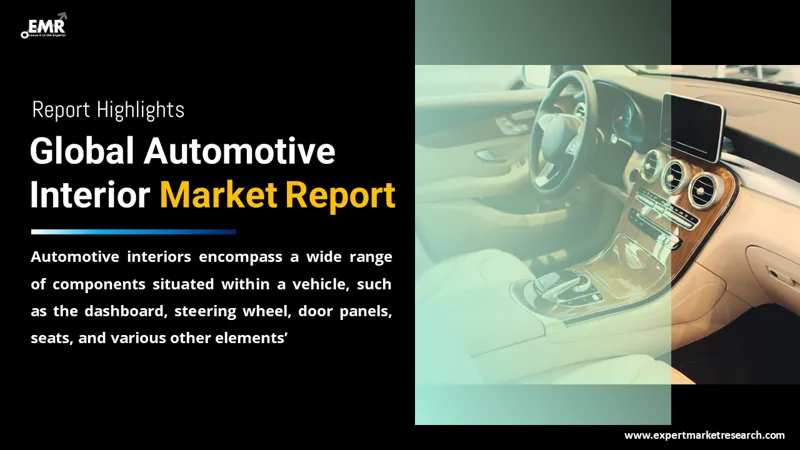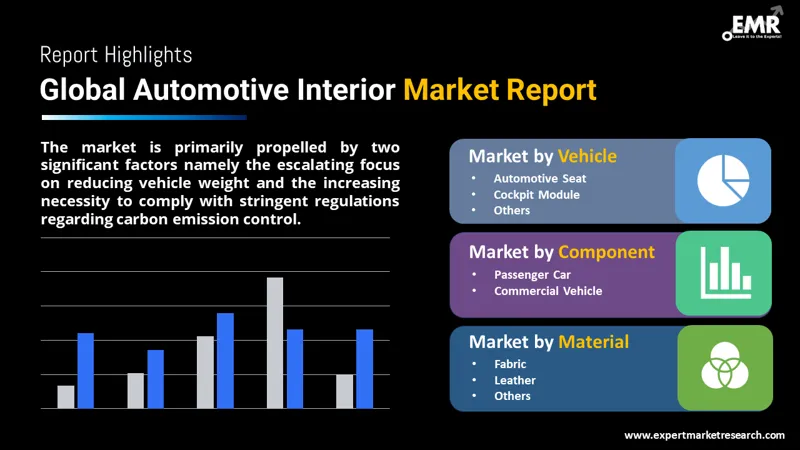
Consumer Insights
Uncover trends and behaviors shaping consumer choices today
Procurement Insights
Optimize your sourcing strategy with key market data
Industry Stats
Stay ahead with the latest trends and market analysis.
The global automotive interior market size reached around USD 176.52 Billion in 2025. The market is assessed to grow at a CAGR of 5.20% between 2026 and 2035, reaching a value of nearly USD 293.06 Billion by 2035.
Base Year
Historical Period
Forecast Period
Compound Annual Growth Rate
5.2%
Value in USD Billion
2026-2035
*this image is indicative*
| Global Automotive Interior Market Report Summary | Description | Value |
| Base Year | USD Billion | 2025 |
| Historical Period | USD Billion | 2019-2025 |
| Forecast Period | USD Billion | 2026-2035 |
| Market Size 2025 | USD Billion | 176.52 |
| Market Size 2035 | USD Billion | 293.06 |
| CAGR 2019-2025 | Percentage | XX% |
| CAGR 2026-2035 | Percentage | 5.20% |
| CAGR 2026-2035 - Market by Region | Asia Pacific | 5.8% |
| CAGR 2026-2035 - Market by Country | India | 5.9% |
| CAGR 2026-2035 - Market by Country | China | 5.7% |
| CAGR 2026-2035 - Market by Component | Cockpit Module | 6.1% |
| CAGR 2026-2035 - Market by Vehicle | Passenger Car | 5.6% |
| Market Share by Country 2025 | France | 3.1% |

Read more about this report - REQUEST FREE SAMPLE COPY IN PDF
Automotive interiors comprise all the components inside of a vehicle, which include a dashboard, steering wheel, door panels, and seats, among others. The interior is an important aspect of a vehicle as passengers and drivers are seeking comfortable and stylish indoor spaces.
The EMR’s report titled “Global Automotive Interior Market Report and Forecast 2026-2035” offers a detailed analysis of the market based on the following segments:
Market Breakup by Component
Market Breakup by Vehicle
Market Breakup by Material
Market Breakup by Region

Read more about this report - REQUEST FREE SAMPLE COPY IN PDF
Plastic is likely to account for a significant portion of the market, as it is one of the most widely used materials in the automotive interior market. The use of plastic in interior components provides multiple benefits as it is highly durable, cost-effective, and offers the flexibility to manufacturers to design vehicles according to their needs. Moreover, injection moulded components are frequently utilised in automotive interior trim to effectively decrease noise, vibration, and harshness (NVH) levels within the cabin.
The Asia Pacific region is expected to aid the overall market growth owing to the presence of a highly developed automotive sector in countries like China, India, and Japan. The region also boasts a huge middle-class population which ensures a high and constant demand for fuel-efficient vehicles.
| CAGR 2026-2035 - Market by | Country |
| India | 5.9% |
| China | 5.7% |
| Mexico | 5.5% |
| UK | 5.1% |
| USA | 4.9% |
| Canada | XX% |
| Germany | 4.6% |
| France | XX% |
| Italy | XX% |
| Japan | XX% |
| Australia | XX% |
| Saudi Arabia | XX% |
| Brazil | XX% |
Moreover, the rising sales of electric vehicles in the region are expected to further propel the automotive interior market development during the forecast period.
The comprehensive EMR report provides an in-depth assessment of the market based on Porter's five forces model along with giving a SWOT analysis. The report gives a detailed analysis of the following key players in the global automotive interiors market, covering their competitive landscape and the latest developments like mergers, acquisitions, investments, and expansion plans.
Yanfeng International Automotive Technology Co. Ltd., commonly known as Yanfeng Automotive, is a leading automotive component supplier. It specialises in the development, manufacturing, and supply of interior and exterior automotive components and systems. Since its establishment in 1936, the company has developed a wide category of products such as interior and exterior components, seating, and cockpit electronics, among others.
Sage Automotive Interiors, Inc., is a global supplier of technical textiles for the automotive sector. The company operates under its parent company Asahi Kasei and specialises in the development of high-performance automotive textiles. Founded in 2009 and headquartered in South Carolina, the United States, Sage Automotive Interiors has rapidly established itself as a leader in the automotive sector.
Grupo Antolin Irausa, S.A. is a Spanish company operating in the field of car interior manufacturing. Since the company’s foundation in the year 1950, it has expanded around the world to become one of the largest global automotive suppliers. The company's product portfolio includes a wide range of interior components such as overhead systems, doors, lighting, seating, and instrument panels.
*Please note that this is only a partial list; the complete list of key players is available in the full report. Additionally, the list of key players can be customized to better suit your needs.*
Other players in the automotive interior market include Adient plc, Faurecia, Toyota Boshoku Corporation, Robert Bosch GmbH, Continental AG, Toyoda Gosei Co., Ltd., DRÄXLMAIER Group, SMS Auto Fabrics, and Tachi-S Engineering U.S.A., Inc., among others.




*While we strive to always give you current and accurate information, the numbers depicted on the website are indicative and may differ from the actual numbers in the main report. At Expert Market Research, we aim to bring you the latest insights and trends in the market. Using our analyses and forecasts, stakeholders can understand the market dynamics, navigate challenges, and capitalize on opportunities to make data-driven strategic decisions.*
Get in touch with us for a customized solution tailored to your unique requirements and save upto 35%!
In 2025, the market reached an approximate value of USD 176.52 Billion.
The market is projected to grow at a CAGR of 5.20% between 2026 and 2035.
The market is estimated to witness a healthy growth in the forecast period of 2026-2035 to reach around USD 293.06 Billion by 2035.
The major drivers of the market include the increasing efforts to reduce vehicle weight and the growing need to comply with stringent carbon emission control regulations.
The development of the market is propelled by the increasing adoption of bioplastics and vegan materials and the rapidly developing market for electric vehicles.
The major regional markets are North America, Europe, the Asia Pacific, Latin America, and the Middle East and Africa.
The different components of the automotive interior include flooring, door panel, interior lighting, automotive seat, and cockpit module, among others.
The key players in the global automotive interior market are Yanfeng International Automotive Technology Co. Ltd., Sage Automotive Interiors, Inc., Grupo Antolin Irausa, S.A., Adient plc, Faurecia, Toyota Boshoku Corporation, Robert Bosch GmbH, Continental AG, Toyoda Gosei Co., Ltd., DRÄXLMAIER Group, SMS Auto Fabrics, and Tachi-S Engineering U.S.A., Inc., among others.
Explore our key highlights of the report and gain a concise overview of key findings, trends, and actionable insights that will empower your strategic decisions.
| REPORT FEATURES | DETAILS |
| Base Year | 2025 |
| Historical Period | 2019-2025 |
| Forecast Period | 2026-2035 |
| Scope of the Report |
Historical and Forecast Trends, Industry Drivers and Constraints, Historical and Forecast Market Analysis by Segment:
|
| Breakup by Component |
|
| Breakup by Vehicle |
|
| Breakup by Material |
|
| Breakup by Region |
|
| Market Dynamics |
|
| Competitive Landscape |
|
| Companies Covered |
|
Datasheet
One User
USD 2,499
USD 2,249
tax inclusive*
Single User License
One User
USD 3,999
USD 3,599
tax inclusive*
Five User License
Five User
USD 4,999
USD 4,249
tax inclusive*
Corporate License
Unlimited Users
USD 5,999
USD 5,099
tax inclusive*
*Please note that the prices mentioned below are starting prices for each bundle type. Kindly contact our team for further details.*
Flash Bundle
Small Business Bundle
Growth Bundle
Enterprise Bundle
*Please note that the prices mentioned below are starting prices for each bundle type. Kindly contact our team for further details.*
Flash Bundle
Number of Reports: 3
20%
tax inclusive*
Small Business Bundle
Number of Reports: 5
25%
tax inclusive*
Growth Bundle
Number of Reports: 8
30%
tax inclusive*
Enterprise Bundle
Number of Reports: 10
35%
tax inclusive*
How To Order

Select License Type
Choose the right license for your needs and access rights.

Click on ‘Buy Now’
Add the report to your cart with one click and proceed to register.

Select Mode of Payment
Choose a payment option for a secure checkout. You will be redirected accordingly.
Gain insights to stay ahead and seize opportunities.

Get insights & trends for a competitive edge.

Track prices with detailed trend reports.

Analyse trade data for supply chain insights.

Leverage cost reports for smart savings

Enhance supply chain with partnerships.

Connect For More Information
Our expert team of analysts will offer full support and resolve any queries regarding the report, before and after the purchase.
Our expert team of analysts will offer full support and resolve any queries regarding the report, before and after the purchase.
We employ meticulous research methods, blending advanced analytics and expert insights to deliver accurate, actionable industry intelligence, staying ahead of competitors.
Our skilled analysts offer unparalleled competitive advantage with detailed insights on current and emerging markets, ensuring your strategic edge.
We offer an in-depth yet simplified presentation of industry insights and analysis to meet your specific requirements effectively.
Share